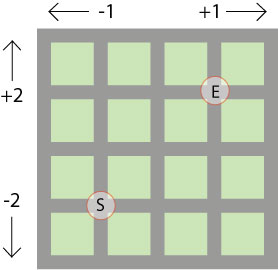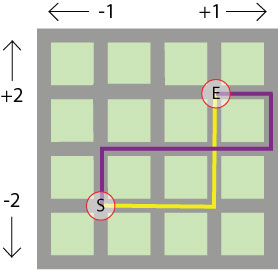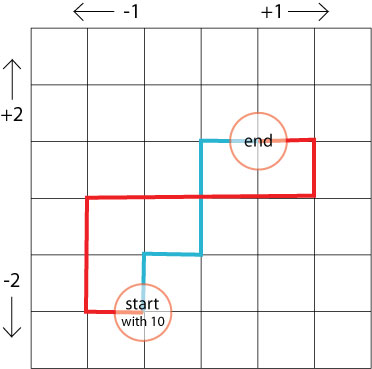Copyright © University of Cambridge. All rights reserved.
The Add and Take-away Path
The Add and Take-away Path printable sheet
Once there was a garden with lots of paths and little patches of grass between them. It looked a bit like this:
Two children, William and Thea, made up a game.
For every patch of grass they passed as they walked to the right on the picture, they added one.
For every patch of grass they passed as they walked to the left on the picture, they took away one.
If they went North (up on the picture), they added two for every patch of grass, and if they went South (down on the picture), they took away two for each patch of grass.
They started with ten points at S, and added and took away until they reached E.
These are the paths they took:
Thea took the yellow path. Remember she started with $10$ points.
How many points did she have when she arrived at E?
William took the purple path.
How many points did he have when he arrived at E?
In the picture below, we've taken out the grass and just drawn a grid. You can imagine that the squares are patches of grass and the lines are the paths in the garden.
We have marked different starting and end points.
What would your score be if you walked along the blue path?
And the red path?
Make up some more paths between these start and end points.
What is your score each time?
What do you notice?
Can you explain why?
Why do this problem?
This problem will give children a chance to generalise and make predictions. It also provides practice in simple addition and subtraction. It draws out the inverse relationship between these two operations as well as encouraging children to think about the order of operations.
In relation to the March 2011 theme, 'actions on objects', we can think of 'going right' as an action performed on the starting number of points (and likewise going in the other directions). We can encourage children to find out what properties these actions have when combined one after the other.
You will need copies of
the grid sheet, which could be enlarged if more than two children are going to work using the copy.Possible approach
You could start by showing the pictures in the first part of the problem to the whole group, making sure that William and Thea's game is understood. A small scale version could be drawn out on the playground or on the hall floor so that the game can be played practically.
After this introduction, the group could work in pairs so that they are able to discuss their ideas with a partner, using copies of the sheet. Encourage them to find interesting routes that use subtraction as well as addition. Routes can be drawn using different colours but pairs may well need more than one copy of the sheet.
At the end of the lesson the group can come together again and discuss their findings. They could show their most interesting and longest routes. What did they notice about the total each time? Were they surprised by this result? Why do they think this happened?
Key questions
How will you remember which routes you have tried out?
How will you remember the total of each route?
Can you find a more interesting way to go?
Can you check your answers another way?
Do you notice anything about the totals?
Possible extension
Possible support
Learners might find it useful to have counters to help keep track of the score. Starting with $10$ counters, they could physically add and take away counters, then count them up when they arrive at the end point.



